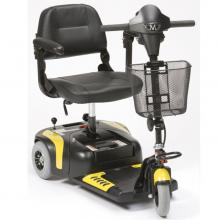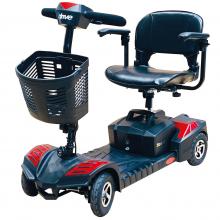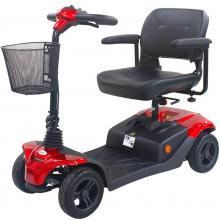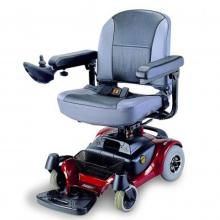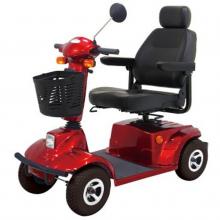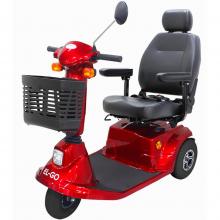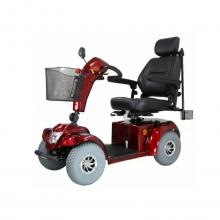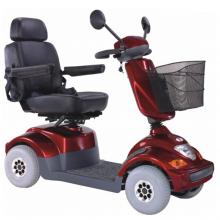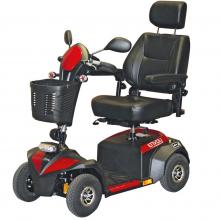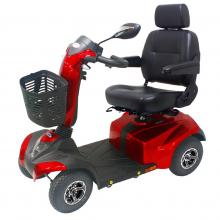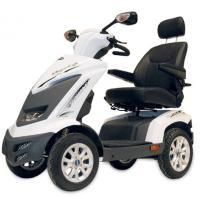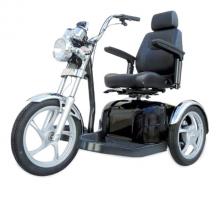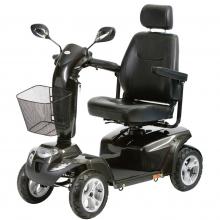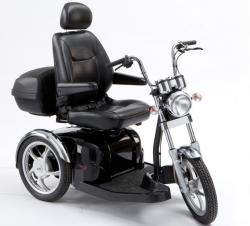Kérdés esetén a info@gyogyaszati.hu email címen tud elérni bennünket.
* Áraink BRUTTÓ árak, az ÁFÁ-t tartalmazzák!
A(z) Scooterek - elektromos hajtású mozgássérült mopedek kategória ismertetője:

A scooterek abban különböznek az elektromos kerekesszékektől, hogy jóval nagyobb mozgékonyságot és tevékenységi szabadságot biztosít a használójánk a szabad teret, az utcát tekintve. Alklamas parkok megtekintésére, bevásárlásra, ismerősök meglátogatására. Használhat 3 és 4 kerekű, alacsony sulyú, nagy terhelhetőségű, összecsukható és fix stb. változatokat.
A mozgássegítő kisautókat, más néven elektromopedeket nem csak rokkantak, hanem minden, mozgásában korlátozott, vagy egyszerűen a kényelmet kedvelő személy használhat, akár utcai közlekedésre is. A felhasználók lehetnek mozgáskorlátozottak, vagy nehezen járó és idős emberek. Ezzel a járművel könnyedén és biztonságosan lehet otthonról kimozdulni, kapcsolatot tartani ismerősökkel, családtagokkal, napi ügyeket intézni, elmenni a hivatalba, bevásárolni (akár az üzlet sorai között is elfér).Azoknak az embereknek, akik mozgási, (otthonról való) kimozdulási problémával küzdenek, vonzó lehetőséget biztosít a mindennapokban való egyedüli boldogulásban. Akik félnek a különböző előítéletektől, vagy nincsenek rászorulva a kerekesszékre (tudnak állni és legalább pár lépést megtenni), azok könnyedén használhatják, és főleg a hagyományos kerekesszékekhez képest nem kell hozzá erőkifejtés. Egy áruházban is könnyedén elboldogul a sorok között.
Két hátsó kerekük van, és legtöbbször ezeket a kerekeket hajtja meg a motor. Elöl egy vagy két kerék segíti a kanyarodást. A kényelmes és időjárásálló ülés két felemelhető karfával van ellátva és beszálláshoz 90 fokban kifordítható. Általában akkumulátor meghajtásúak.Az akkumulátor „ereje” határozza meg a megtehető út hosszát, a maximális sebességet, és a lejtő magasságát, amin fel tud kapaszkodni. Általában az akkumulátortöltő külön áll, de terjedőben a beépített akkumulátor töltő, melynek előnye, hogy ha lemerül, akkor csak egy hálózatot kell keresnünk és egy kis töltés után mehetünk tovább. A járművek „műszerfalán” állíthatjuk a sebességet, indexelhetünk, dudálhatunk, kapcsolhatjuk a világítást. Ezen a panelen helyezkedik el az akku töltöttségi szint jelzője és a „slusszkulcs” helye is. Irányítása típusfüggő: karokkal, fülekkel kormányozható, melyek minden esetben biztosítják az egykezes kezelést, azaz fél kézzel az előre- és hátramenet fél kézzel kapcsolható. A sebesség ezekkel a karokkal is szabályozható: a kar elengedésével az elektromos fékek automatikusan működésbe lépnek, és megáll a jármű. Amíg nem indulunk meg újra, a fékek zárva maradnak, így mopedünk nem gurul el. Éppen ezért ha mopedünk lemerülne, akkor a féket kioldható és így a gépet eltolható. Sötétben való meneteléshez lámpával van felszerelve.
Számos kiegészítő vásárolható hozzá, amely nem csak a kényelmet biztosítja, hanem a betegek állapotának javítására is szolgálhat: oxigén palack tartó, zárható csomagtartó, esőkabát, járókeret tartó, garázs, hordtáskák...
A mobility scooter is a mobility aid equivalent to a wheelchair but configured like a motorscooter. It is often referred to as a power-operated vehicle/scooter or electric scooter as well.A mobility scooter has a seat over three, four or now five wheels, a flat area or foot plates for the feet, and handlebars in front to turn one, two or three steerable wheels. The seat may swivel to allow access when the front is blocked by the handlebars. Mobility scooters are usually battery powered. A battery or two is stored on board the scooter and is charged via an onboard or separate battery charger unit from standard electric power. Gasoline-powered scooters may also available in some countries, though they are rapidly being replaced by electric models.
The tiller, with forward/reverse directions and speed controls, is the steering column centrally located at the front of the scooter. Forward/reverse direction can be controlled by thumb paddles, finger controls, or a switch. There are two types of mobility scooters: front-wheel drive (FD) or rear-wheel drive (RD). The FD is usually a smaller device and is best used indoors. Rider weight capacity is generally upwards to 250 pounds maximum. The RD is used both indoors and outdoors with rider weight capacity of 350 pounds. A heavy duty rear-drive can carry up to 500 pounds, varying by manufacturer.
Assistive and small sit-down motor scooters provide important advantages to people with mobility problems throughout the world. A scooter is useful for persons without the stamina or arm/shoulder flexibility necessary to use a manual wheelchair. Also, swiveling the seat of an electric scooter is generally easier than moving the foot supports on most conventional wheelchairs. A mobility scooter is very helpful for persons with systemic or whole-body disabling conditions (coronary or lung issues, some forms of arthritis, obesity, etc.) who are still able to stand and walk a few steps, sit upright without torso support, and control the steering tiller.
A major selling point of mobility scooters for many users is that they do not look like a wheelchair, disability still being seen by many as a negative or somehow shameful. Mobility scooters are in general more affordable than powered wheelchairs, leading to them being procured as a cheaper alternative.While a mobility scooter eliminates much of the manual strength problems of an unpowered wheelchair, its tiller steering mechanism still requires upright posture, shoulder and hand strength, and some upper-body mobility and strength. The arm-rest mounted controller typical of powerchair designs may be more suitable for many users. Scooters also have fewer options for body support, such as head or leg rests. They are rarely designed for ease of patient transfer from seat to bed.
Other drawbacks include longer length, which limits their turning radius and ability to use some lifts or wheelchair-designed access technologies such as kneeling bus lifts. Some mobility scooter have low ground clearance which can make it difficult to navigate certain obstacles, such as travelling in cities without proper curb cuts. Navigating in restricted spaces, whether in the home or in public spaces and buildings can also be a problem.
These limitations may prevent some disabled individuals from using scooters. In addition, scooter limitations may vary depending on model and manufacturer. A limitation of one make/model does not necessarily carry over to all. Individual needs may affect the suitability of a particular model.
Currently in the United States, Medicare will not approve a power wheelchair for persons who do not need to use the chair "inside their own home", even if their medical needs restrict the use of a mobility scooter. For example, a person with severe arthritis of both shoulders and hands may not be the best candidate for a scooter, but because they can walk a few steps in their own home, such persons are not seen as approved candidates for a power wheelchair either. Various disability rights groups are campaigning for Medicare to change this policy. For those who do qualify for Medicare, they can reimburse up to 80% of the total value of the scooter.[2]
Similar restrictions on NHS powerchair provision exist in the UK, with manual wheelchairs prescribed for users with any ability to walk. This has led to many users who might be better served by a powerchair privately procuring a mobility scooter as a cheaper substitute.
- Alakformálás, tartásjavítás
- Automata felkaros vérnyomásmérők
- Chi készülékek
- Csuklós vérnyomásmérők
- DVD tájékoztató filmek
- Egészségügyi matracok
- Elektromos masszírozók
- Fájdalomcsillapítás
- Félautomata felkaros vérnyomásmérők
- Fémszálas textíliák és reztermékek
- Fényterápiás eszközök
- Fittness
- Gimnasztikai labdák és termékek
- Gimnasztikai szalagok
- Gyógypárnák, gyógyászati párnák
- Hőterápiás termékek
- Kézi masszírozók
- Lábápolás - talpbetétek
- Légzésterápiás eszközök
- Lépéssszámlálók
- Mágneses termékek
- Méregtelenítés
- Mérlegek
- Nyugodt alvás
- Papucsok, kényelmi lábbelik
- Párásító, párologtató készülékek
- Probiotikumok
- Szájhigiénia
- Szépségápolás
- Testzsírmérők
- Vércukor-vérnyomásmérő egyben
- Vércukorszintmérők
- Víz, víztisztítás, háztartás
- Ápolási krémek, bőrvédők, mosdatás
- Ápolási tusolószékek - fürdetőszékek
- Beteg mozgás-mozgatás az ágynál
- Betegágy - ágykörüli termékek
- Betegágy - tartozékok, kiegészítők
- Betegágyak - elektromos ápolási ágy
- Betegágyak - mechanikus ápolási ágyak
- Betegápolási ruházat
- Betegemelő liftek és szállítószékek
- Betegrögzítők - kerekesszékbe
- Betegrögzítők betegágyba
- Étkezés - táplálás
- Felfekvés elleni egyéb termékek
- Felfekvés elleni/antidecubitus komplett matracok
- Füldugók, fülvédő eszközök
- Fürdőszoba ápolási segédeszközei
- Gyermek ápolás termékei
- Gyógyászati - ápolási párnák
- Gyógyszeradagolók - gyógyszerfelezők
- Higiénia az ágy körül
- Inkontinencia nadrágpelenkák - belebújós
- Inkontinencia termékek - beteg alátétek
- Inkontinencia termékek - betétek
- Inkontinencia termékek - éjszakára pelenkák
- Inkontinencia termékek - férfi betétek
- Inkontinencia termékek - nappali pelenkák
- Inkontinencia termékek - rögzítő nadrágok
- Kádliftek
- Matracok betegágyhoz - fedőmatracok
- Matracok betegágyhoz - memory réteggel
- Matracok betegágyhoz - szivacs
- Rollátorok
- Takarítás, ágyazás eszközei
- Tisztasági betétek
- Vízhatlan matracvédők
- Ágyéki- és keresztcsonti ortézisek, derékövek, derékszorítók
- Alkarrögzítők, alkarsinek
- Befecskendező eszközök, tűk, fecskendők
- Boka-lábszár rögzítők
- Bokaortézisek, bokarögzítők, bokaszorítók
- Csípőortézisek
- Csukló ortézisek, csukló és kézfej rögzítők
- Elektromos kerekesszék alkatrészek
- Enterostoma, colostoma termékek
- Fali kapaszkodók, WC kapaszkodók, fürdőkád kapaszodók
- Fáslik, rugalmas pólyák
- Felfekvés kezelése, megelőzése, matracok, párnák
- Gégészeti termékek
- Gerincnyújtás eszközei
- Hallást segítő eszközök
- Hasi- és ágyéksérv eszközei, sérvkötők, haskötők
- Inhalátor alkatrészek
- Inhalátorok - kompresszoros
- Inhalátorok - ultrahangos zajmentes
- Inzulinbeadó eszközök
- Izom- és idegingerlő készülékek, TENS
- Izomingerlő és TENS tartozékok
- Járóbotok, mankók
- Járókeretek, gurulós járókeretek - rollátorok
- Karharisnyák, felső végtag kompressziós termékek
- Kerekesszék - elektromos
- Kerekesszék alkatrészek / kiegészítők
- Kerekesszékek - aktív
- Kerekesszékek - kézi hajtású
- Kompessziós alsó végtag harisnyák
- Könyök ortézisek
- Lábfej ortézisek, lábujj bütyök kezelők
- Lábfej specialisták
- Látásgyakorlás eszközei, szemtakarók
- Mosdatás, fürdetés, zuhanyzás eszközei
- Nyaki ortézisek, nyakrögzítők
- Nyaki-mellkasi ortézisek, mellkasszorítók
- Nyakpárnák
- Nyiroködéma és egyéb ödémák kezelésének eszközei
- Nyújtók, nyújtókészülékek
- Scooter kiegészítők
- Scooterek - elektromos hajtású mozgássérült mopedek
- Szoba WC
- Talpbetétek, ludtalpbetétek
- Térdortézisek, térdrögzítők, térdszorítók
- Tesztcsíkok
- Ujj ortézisek, ujjrögzítők
- Ülőpárnák, derékpárnák
- Váladékszívók, leszívóeszközök
- Vállrögzítők
- Vércukormérő tartozékok
- Vércukormérők
- Vizeletürítés eszközei: katéterzsákok
- Vizeletürítés eszközei: vizelet katéterek
- WC magasítók
- Alkoholszondák
- Audiométerek
- Autokláv sterilizátorok
- Automata vérnyomásmérők
- Betegágyak és tartozékai
- Betegörző monitorok
- Bőrfertőtlenítők, nyálkahártyafertőtlenítők
- Defibrillátorok
- Dermatoszkopok - bőrgyógyászat
- Dopplerek, CTG
- Egészségügyi oktatási eszközök,
- Egyéb eszközök
- Egyszer használatos eszközök
- EKG készülékek
- EKG papírok, EEG papírok, UK papírok
- EKG tartozékok
- Elektromos intenzív beteg ágyak
- Elektrosebészet, mikrosebészet
- Felület fertőtlenítők
- Fertőtlenítő adagolók
- Fizikoterápiás eszközök
- Fonendoszkópok és tartozékaik
- Fül-orr-gégészeti eszközök
- Gasztroenterológiai eszközök
- Higanymentes, hagyomásnyos orvosi vérnyomásmérők
- Higienia a rendelőben
- Holterek
- Hordágyak
- Hőmérők, lázmérők
- Inhalátorok, párásítók, légtisztítók
- Készenléti és sürgősségi táskák
- Kézápolók, bőrápolók, regeneráló szerek
- Kézfertőtlenítők, bőrfertőtlenítők, fertőtlenítő szappanok
- Kézi műszerek
- Kéztörlő adagolók
- Kolposzkópok
- Laboratoriumi eszközök
- Laborkészülékek
- Lámpák, fényforrások
- Laryngoszkópok, reanimációs eszközök
- Légzésterápiás eszközök
- Mérlegek, magasságmérők
- Műszer- és eszközfertőtlenítők
- Műtéti fogyóeszközök - izoláció eszközei
- Nőgyógyászat
- Oftalmoszkopok, szemészeti műszerek
- Órás vérnyomásmérők
- Orvosi bútorok - asztalok, műszerasztalok
- Orvosi bútorok - egyéb bútorok
- Orvosi bútorok - műtő szoba
- orvosi butorok - proctologia
- Orvosi bútorok - székek, ülőbútorok
- Orvosi bútorok - szekrények
- Orvosi bútorok - várótermi bútorok
- Orvosi bútorok - vizsgáló ágyak
- Otoszkópok
- Proktológia
- Pulzoximéterek
- Reflexkalapácsok, rozsdamentes acél kézi műszerek
- Rozsdamentes orvosi eszközök
- Ruházat, lepedők, textiláruk, papucsok
- Sebészeti koagulátorok és tartozékai
- Spirométerek
- Sterilizáló dobozok
- Sterilizátorok
- Sürgősségi betegellátás és elsősegély eszközei
- Számítástechnika, irodatechnika
- Szemészet, optika
- Színlátásvizsgáló könyvek
- Tartozékok, kiegészítők
- Táskák, orvosi táskák
- Tesztcsíkok
- Tisztítószerek, csírátlanítók, szagtalanítok
- Toalett higénia
- Ultrahang készülékek, tartozékaik
- Váladékszívók
- Védőeszközök, védőfelszerelések
- Vér- és infúziós melegítők
- Vércukormérők
- Vérnyomásmérő alkatrészek
- Bokaszorítók, boka bandázsok
- Combszoritók, combrögzítők
- Csuklószorítók, csuklóbandázsok
- Derékszorítók, gerinctartók
- Könyökszorítók, könyökbandázsok
- Masszázságyak
- Masszázskellékek
- Sport tapaszok
- Sportkrémek, sportkenőcsök
- Tartásjavító termékek
- Térdszorítók, sport térdrögzítők
- Vállvédők, váll és kulcscsont rögzítők
- Betegemelő liftek
- Betegemelő tartozékok
- Egymotoros betegállító és fektető fotelek
- Életviteli eszközök - fürdőszoba, higiénia segéd
- Életviteli eszközök - konyhai, étkezés eszközök
- Életviteli eszközök - öltözködés, házimunka
- Gerinc rehabilitáció
- Gyengénlátás eszközei
- Gyermek rehabilitációs termékek
- Gyógytorna eszközök - Egyensúlyozás-koordináció
- Gyógytorna eszközök - kar és vállfejlesztő eszközök
- Gyógytorna eszközök - Kézerő, kézügyesség fejlesztő
- Gyógytorna eszközök - láb rehabilitáció
- Gyógytorna eszközök - masszázs termékek
- Kényelmi bútorok - betegszoba bútorok
- Kétmotoros betegállító fotelek
- Medenceliftek
- BERKEMANN biopapucsok
- BIOKOMFORT biopapucsok
- BIRKENSTOCK lábbelik
- BLUSTEP biopapucsok
- Cipőápolási termékek
- COMFORT lábbelik
- Healthy Line biopapucsok
- HIRSCH biopapucsok
- KOPITARNA lábbelik
- MEMO szupináló gyerekcipők
- SALUS szupináló gyerek szandálok
- SALUS szupináló szandálcipők
- SALUS zárt gyerekcipők nem béléses
- SCHOLL FÉRFI LÁBBELIK
- SCHOLL MUNKAHELYI
- SCHOLL NŐI MODELLEK
- Alginátok
- Csőkötszerek
- Filmkötszerek
- Hydrocolloid kötszerek
- Hydrogélek
- Impregnált kötszerek
- Kötésrögzítők
- Mull-lapok
- Nedvszívó sebpárnák, habkötszerek
- Polimer kötszerek
- Ragtapaszok
- Sebösszehúzó kötszerek
- Szigetkötszerek, sebtapaszok
- Tupferek, tamponok
- Vatták
- Vénakanül-, vénás eszköz rögzítők
- Vérzéscsillapító termékek
* Elküldheti nekünk webáruházunkkal kapcsolatos észrevételeit, fejlesztési tanácsait.


